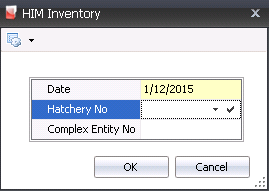

The Egg Room inventory view displays the available egg room inventory at all locations. The view can be filtered or grouped as required to view specific data. Once the filters and groups are applied, the settings will be saved in the user profile until the filters or groups are modified.
Before viewing the Egg Room inventory, eggs must have been put in the inventory in the hatchery through one of the following transactions:



Transport Destination Hatchery No indicates the final destination hatchery for the eggs that were transferred between hatcheries.
Transport Destination Hatchery Name displays the name of the final destination hatchery.
Egg Age displays the age of the eggs and is based on: Received Date - Production Date.
Flock Age displays the age of the flock and is based on the selected entity and the production date.
WOL displays the number of weeks in lay that the entity produced eggs.
Inventory Date displays the last date that inventory was taken.
The Consignment flag will be selected if the eggs were purchased using a Consignment Purchase Order.
Egg Weight displays the weight per egg, or a single average weight of all the eggs in inventory.
Egg Class No indicates the class of the eggs in inventory.
Egg Class Name displays a description of the egg class.
Projected Hatch indicates the adjusted based hatch percent on the egg age if an egg age decline table is used as well as recent hatch transactions.